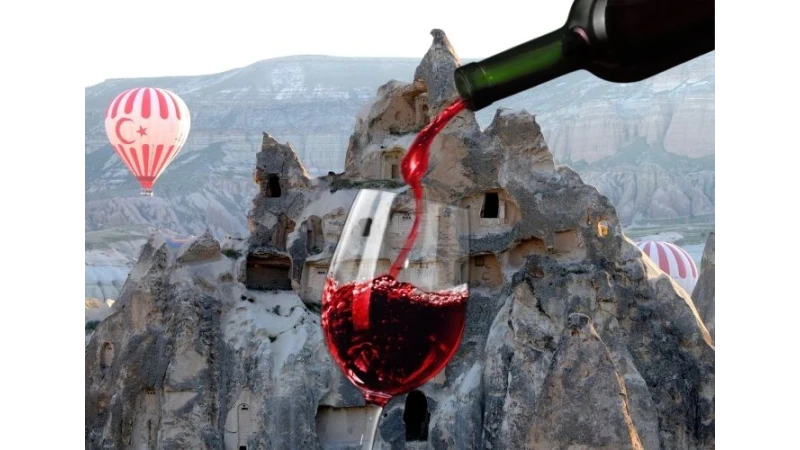Cappadocian Wine – Vineyards, Wine Tasting & History

🍷 Cappadocian Wine – Vineyards, Wine Tasting & History
Cappadocia, widely known for its fairy chimneys and hot air balloon rides, also has a hidden treasure that many travelers overlook: wine culture. The region’s unique volcanic soil, ancient winemaking traditions, and sun-kissed vineyards make it one of the most important wine-producing areas in Turkey.
For centuries, locals have cultivated grapes and perfected the art of winemaking. Today, visitors can explore vineyards, wine houses, and cellars while experiencing the taste of Cappadocia’s heritage in every sip. This guide takes you through the history of Cappadocian wine, top vineyards, wine tasting experiences, and why Cappadocia should be on every wine lover’s bucket list.
🏛️ The Ancient History of Cappadocian Wine
The story of wine in Cappadocia dates back thousands of years. Archaeological evidence shows that the Hittites, who lived in Central Anatolia around 4,000 years ago, were already cultivating grapes and producing wine.
Later, the Byzantines and Ottomans continued the tradition, making Cappadocia a vital center for viticulture. The region’s volcanic tuff soil, rich in minerals, combined with its dry climate and hot summers, creates ideal conditions for grape growing.
Even today, many local families continue traditional winemaking methods, keeping the culture alive while combining it with modern techniques.
🍇 Vineyards of Cappadocia – Where the Magic Happens
Cappadocia’s vineyards are spread across Ürgüp, Avanos, Mustafapaşa, and Nevşehir. The most famous grape varieties grown here include:
- Emir – A white grape unique to Cappadocia, known for its light and fresh taste.
- Kalecik Karası – A red grape producing smooth and fruity wines.
- Öküzgözü – Deep-colored red wine with rich aromas, often blended with other grapes.
- Boğazkere – A bold red variety with strong tannins, ideal for aging.
Walking through Cappadocia’s vineyards is more than just sightseeing – it’s a journey into history, tradition, and authentic Anatolian flavors.
🍷 Cappadocia Wine Tasting Experiences
Wine tasting is one of the most enjoyable activities in Cappadocia. Many local producers and boutique wineries open their doors to visitors, offering guided tours, cellar visits, and tasting sessions.
Top Wine Experiences:
- Turasan Winery (Ürgüp): One of the oldest and most famous wineries in Cappadocia, offering professional wine tasting and guided vineyard tours.
- Kocabag Winery (Uçhisar): Famous for blending traditional methods with modern production. Their wine cellars carved into volcanic rock provide an unforgettable atmosphere.
- Small Family Wineries: In villages like Mustafapaşa or Avanos, local families offer authentic, homemade wines that tell the story of the land.
During tastings, you can pair wines with Turkish cheeses, olives, and mezes – a perfect way to connect with the local culture.
🏺 Wine Cellars in Volcanic Rock
One of the unique features of Cappadocian wine is the use of rock-carved wine cellars. Thanks to the volcanic tuff, which naturally regulates temperature and humidity, these cellars are ideal for storing and aging wine.
Many of these caves are still in use today, allowing visitors to step inside and feel as if they’ve traveled back in time.
🌄 Wine & Culture – More Than Just a Drink
Wine in Cappadocia is not only about taste but also about cultural heritage. For locals, winemaking is part of daily life, connected to family, hospitality, and celebration.
Visitors who take part in wine tours often describe the experience as a combination of history, tradition, and sensory discovery. From sipping Emir wine while watching the sunset over the fairy chimneys to attending a tasting session inside an ancient cave cellar, Cappadocian wine is truly unforgettable.
🍽️ Food Pairings with Cappadocian Wine
To enjoy Cappadocian wine to the fullest, pairing it with the right food is essential:
- 🥂 Emir (White Wine): Perfect with fish, salads, and light Turkish mezes.
- 🍷 Kalecik Karası: Goes well with grilled chicken, kebabs, and lamb.
- 🍇 Öküzgözü & Boğazkere: Best paired with red meat, stews, and strong Anatolian cheeses.
Many local restaurants in Ürgüp and Göreme offer wine & food tasting menus, making it easy to explore both gastronomy and viticulture together.
🕒 Best Time for Wine Lovers to Visit Cappadocia
While Cappadocia is beautiful year-round, September and October are especially exciting for wine enthusiasts. This is the harvest season, when vineyards are full of activity and festivals.
Spring (April–June) is also a great time, with pleasant weather and blooming landscapes making vineyard tours more enjoyable.
💡 Travel Tips for Cappadocia Wine Tours
- Book guided wine tours in advance – spots can be limited during high season.
- Try local varieties like Emir, which you won’t find anywhere else in the world.
- Visit more than one winery to compare different styles and methods.
- Buy direct from local producers – a bottle of Cappadocian wine makes the perfect souvenir.
- Combine wine tours with cultural activities such as pottery workshops in Avanos or Turkish Night shows for a complete experience.
🏆 Conclusion – Why Cappadocian Wine is Special
Cappadocia is not only about hot air balloons and fairy chimneys – it’s also the heart of one of Turkey’s oldest winemaking traditions. With its volcanic soil, unique grape varieties, and rock-carved cellars, Cappadocian wine offers an experience that combines history, culture, and taste.
Whether you’re a wine enthusiast or a curious traveler, exploring Cappadocia’s vineyards and wine houses is a must. Each sip tells the story of the land, the people, and the timeless traditions of this fairytale region.
✨ Discover Cappadocia through its wine – taste history in every glass!













